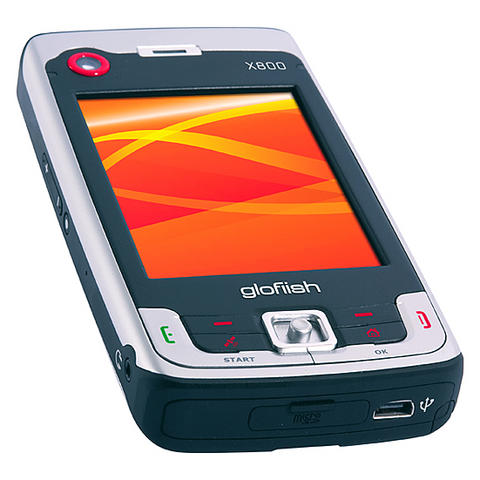After months of sweaty-palmed anticipation, the iPhone has finally landed. However, unless you live in the US and subscribe to AT&T you are sadly out of luck - you can't buy one. But are there any alternatives if you can't wait?
Taipei-based HTC believes there is. The organization, until recently branded Dopod in Taiwan's domestic market, is now rolling out globally under the corporation's original moniker, and the Touch is its first product. As such, a lot is riding on the cell phone's successful reception.
The spec sheet is comparable to the iPhone - a big touch screen, camera, mobile e-mail, and a keyboard that is notable only by its absence. It runs the very latest variant of Windows Mobile, so the guys at Microsoft will also be watching this product launch with particular interest.

It's difficult not to be impressed by the Touch's diminutive size, rounded form, rubbery paint and neat design details, such as the way the status LEDs are placed behind the speaker grille. Ignoring the cheap-looking chrome trim from around the camera, it's clear that this is the company's most concerted attempt yet to break out of the business device field - it is very good looking, and is already a hit with the girls in the office.
HTC's Industrial Designer, Francois Bellet-Odent, said the collection of rocks and pebbles scattered around his Taipei office were referenced when designing the phone's form. Considerable design and engineering effort was focused on removing the step between the case of the phone and the screen, which would ruin the otherwise very soft form - something that plagues most touch screen devices.
The big news, however, is the update to the user interface, dubbed TouchFlo. The first element is a remodeled home screen that is a replacement for the regular Windows display. It's a big improvement, and presents the user with large, nicely drawn buttons for composing new messages, checking the weather or checking for missed calls - and it even tells the time. Apple's influence is plain to see, but it is no less attractive for that.

The second is the TouchCube UI, which forms the basis of HTC's advertising effort. Essentially, it's a flashy program launcher that allows the user to access the most important applications using one hand alone. It's activated by swiping your thumb or finger up the screen, and then you spin the "cube" sideways to see one of three views - your most important contacts, media and photos, and applications.
More astute readers will be wondering why the cube only has three sides, and unfortunately this is not the product's only slipup. The touch screen is not very responsive and requires a surprising degree of pressure to encourage it to work properly, and if the screen is anything close to being free of grease the user's finger stutters across. None too smooth.
When it works, flipping between the three panels is quite fun, right up until the point when you need to do anything useful like write an SMS, when you are ejected, naked and shivering, back into the world of Windows Mobile. There is then no choice but to slide out the stylus and begin poking away at the on-screen keyboard, squinting at the tiny characters. The Internet experience is even worse: pages load in entirely unexpected ways, and scrolling side-to-side trying to read an article quickly becomes frustrating.

Despite its flaws the Touch still impresses. If you are a committed Windows Mobile user looking for something more pocket-sized, unimpressed by the LG Prada phone's cynical branding, or cannot bear to wait until Apple's baby reaches these shores, this may be the phone for you. But an iPhone it is not.
NT$15,900; Stores nationwide; Available now
Taiwan's other contenders:

PHOTO: COURTESY OF ASUS
Glofiish X800
Cell phones are packing more and more equipment into ever-smaller packages. The Glofiish X800 is a case in point, and loads GPS (unlike the iPhone) and WiFi into its flashy looking exterior. The name is strange, but the design and engineering seem solid - it won the Best of Computex award this year.
NT$27,000; Available fall 2007
Asus P525
The Asus P525 employs a combination of a standard keypad with a touch screen, and looks rather similar to the Sony Ericsson P990i. It is aimed at the serious business user, and as a result looks pretty dull and grey. If you are going to have a keyboard at the base of the screen, you may as well have a bigger one, in the style of a Treo or Blackberry.
NT$16,900; PDA King; Available now
Dopod C800
Many people remain unconvinced that a touch screen for keyboard-intensive tasks, such as sending e-mail on the move, will work well. HTC have a number of models that slide open to reveal a generously big thumb keyboard but that are still small enough to slide into the pocket. The Dopod line is likely to get sidelined as the company shifts its focus to the Touch, so good deals may be available for this already established product in the future.
NT$19,999; Sogi.com; Available now
-- Jonathan Biddle is head of industrial design at DEM Inc, Taipei

On a hillside overlooking Taichung are the remains of a village that never was. Half-formed houses abandoned by investors are slowly succumbing to the elements. Empty, save for the occasional explorer. Taiwan is full of these places. Factories, malls, hospitals, amusement parks, breweries, housing — all facing an unplanned but inevitable obsolescence. Urbex, short for urban exploration, is the practice of exploring and often photographing abandoned and derelict buildings. Many urban explorers choose not to disclose the locations of the sites, as a way of preserving the structures and preventing vandalism or looting. For artist and professor at NTNU and Taipei

March 10 to March 16 Although it failed to become popular, March of the Black Cats (烏貓進行曲) was the first Taiwanese record to have “pop song” printed on the label. Released in March 1929 under Eagle Records, a subsidiary of the Japanese-owned Columbia Records, the Hoklo (commonly known as Taiwanese) lyrics followed the traditional seven characters per verse of Taiwanese opera, but the instrumentation was Western, performed by Eagle’s in-house orchestra. The singer was entertainer Chiu-chan (秋蟾). In fact, a cover of a Xiamen folk song by Chiu-chan released around the same time, Plum Widow Missing Her Husband (雪梅思君), enjoyed more

Last week Elbridge Colby, US President Donald Trump’s nominee for under secretary of defense for policy, a key advisory position, said in his Senate confirmation hearing that Taiwan defense spending should be 10 percent of GDP “at least something in that ballpark, really focused on their defense.” He added: “So we need to properly incentivize them.” Much commentary focused on the 10 percent figure, and rightly so. Colby is not wrong in one respect — Taiwan does need to spend more. But the steady escalation in the proportion of GDP from 3 percent to 5 percent to 10 percent that advocates

From insomniacs to party-goers, doting couples, tired paramedics and Johannesburg’s golden youth, The Pantry, a petrol station doubling as a gourmet deli, has become unmissable on the nightlife scene of South Africa’s biggest city. Open 24 hours a day, the establishment which opened three years ago is a haven for revelers looking for a midnight snack to sober up after the bars and nightclubs close at 2am or 5am. “Believe me, we see it all here,” sighs a cashier. Before the curtains open on Johannesburg’s infamous party scene, the evening gets off to a gentle start. On a Friday at around 6pm,